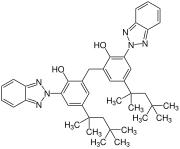2-(2-Hydroxyphenyl)-2H-benzotriazole

2-(2-Hydroxyphenyl)-2H-benzotriazole (auch 2-Hydroxyphenylbenzotriazole oder Hydroxyphenylbenzotriazole[1]) sind eine wichtige Klasse von UV-Absorbern.[2]
Aufbau
Es handelt sich um substituierte Benzotriazole mit einer Phenylgruppe in 2-Position, die in ortho-Stellung eine Hydroxygruppe trägt.[3]
| Name | Akronym | Strukturformel | R1 | R2 | R3 |
|---|---|---|---|---|---|
| 2-(2H-Benzotriazol-2-yl)-4-methylphenol | UV-P |  | – | Methyl | – |
| 2-(2H-Benzotriazol-2-yl)-4-tert-butylphenol | UV-PS |  | – | tert-Butyl | – |
| 2-(2H-Benzotriazol-2-yl)-4,6-bis(2-phenyl-2-propanyl)phenol | UV-234 |  | (2-Propanyl)phenol | (2-Propanyl)phenol | – |
| 2-(2H-Benzotriazol-2-yl)-4,6-di-tert-butylphenol | UV-320 |  | tert-Butyl | tert-Butyl | – |
| 2-(5-Chlor-2H-benzotriazol-2-yl)-4-methyl-6-di-tert-butylphenol | UV-326 |  | tert-Butyl | Methyl | Chlor |
| 2-(5-Chlor-2H-benzotriazol-2-yl)-4,6-di-tert-butylphenol | UV-327 |  | tert-Butyl | tert-Butyl | Chlor |
| 2-(2H-Benzotriazol-2-yl)-4,6-di-tert-pentylphenol | UV-328 |  | tert-Pentyl | tert-Pentyl | – |
| 2-(2H-Benzotriazol-2-yl)-4-(1,1,3,3-tetramethylbutyl)phenol | UV-329 |  | – | 1,1,3,3-Tetramethylbutyl | – |
| 2-(2H-Benzotriazol-2-yl)-6-(sec-butyl)-4-(tert-butyl)phenol | UV-350 |  | sec-Butyl | tert-Butyl | – |
| 2,2′-Methylenbis[6-(2H-benzotriazol-2-yl)-4-(2,4,4-trimethyl-2-pentanyl)phenol] | UV-360 |  | über Methylengruppe verknüpftes Dimer | 1,1,3,3-Tetramethylbutyl | – |
| 2-(2H-Benzotriazol-2-yl)-6-dodecyl-4-methylphenol | UV-571 |  | Dodecyl (linear oder verzweigt) | Methyl | – |
| 2-(2H-Benzotriazol-2-yl)-6-(2-phenyl-2-propanyl)-4-(2,4,4-trimethyl-2-pentanyl)phenol | UV-928 |  | (2-Propanyl)phenol | 1,1,3,3-Tetramethylbutyl | – |
Verwendung
2-(2-Hydroxyphenyl)-2H-benzotriazole kommen als Lichtschutzmittel in Lacken und Kunststoffen zum Einsatz.[3]
Einzelnachweise
- ↑ M. Grob et al.: Handbuch Kunststoff Additive. Hrsg.: R. D. Maier, M. Schiller. 4., vollständig neu bearbeitete Auflage. Carl Hanser Verlag GmbH & Co. KG, 2016, Lichtschutzmittel, S. 155–467, doi:10.3139/9783446432918.002.
- ↑ Eintrag zu UV-Absorber. In: Römpp Online. Georg Thieme Verlag, abgerufen am 25. Januar 2020.
- ↑ a b Eintrag zu 2-(2-Hydroxyphenyl)-2H-benzotriazole. In: Römpp Online. Georg Thieme Verlag, abgerufen am 25. Januar 2020.
Auf dieser Seite verwendete Medien
Struktur von UV-320 (Tinuvin 320)
Struktur von UV-P (Drometrizol)
Allgemeine Struktur von 2-(2-Hydroxyphenyl)-2H-benzotriazolen
Struktur von UV-234 (Tinuvin 234)
Struktur von UV-360 (Tinuvin 360)
Struktur von UV-928 (Tinuvin 928)
Struktur von UV-329 (Tinuvin 329)
Strukturformal von 2-(2H-Benzotriazol-2-yl)-6-dodecyl-4-methylphenol (UV-571)
Struktur von UV-326 (Tinuvin 326)
Struktur von UV-PS
Struktur von UV-328 (Tinuvin 328)
Struktur von UV-327 (Tinuvin 327)
Struktur von UV-350 (Tinuvin 350)












